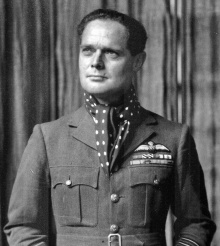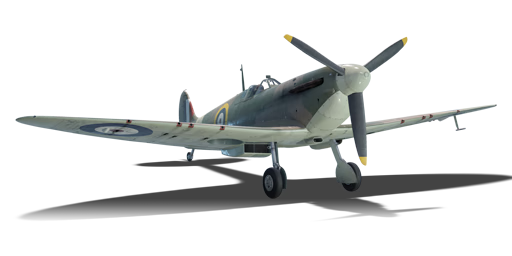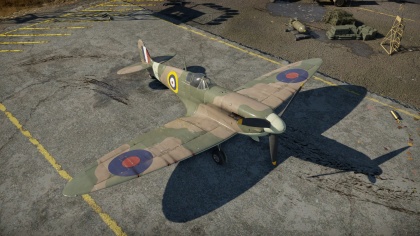Difference between revisions of "Spitfire Mk IIa"
(→General info: moved MEC control to general info) |
|||
| Line 116: | Line 116: | ||
|- | |- | ||
| 4,490 m || 1,140 hp || 1,311 hp | | 4,490 m || 1,140 hp || 1,311 hp | ||
| + | |- | ||
| + | |} | ||
| + | |||
| + | ===Manual Engine Control=== | ||
| + | {| class="wikitable" style="text-align:center" | ||
| + | |- | ||
| + | ! colspan="7" | MEC elements | ||
| + | |- | ||
| + | ! rowspan="2" |Mixer | ||
| + | ! rowspan="2" |Pitch | ||
| + | ! colspan="3" |Radiator | ||
| + | ! rowspan="2" |Supercharger | ||
| + | ! rowspan="2" |Turbocharger | ||
| + | |- | ||
| + | ! Oil | ||
| + | ! Water | ||
| + | ! Type | ||
| + | |- | ||
| + | | Controllable || rowspan="2" | Controllable<br>No automatic pitch || rowspan="2" | Controllable || rowspan="2" | Not controllable || rowspan="2" | Combined || rowspan="2" | Not controllable || rowspan="2" | Not controllable | ||
|- | |- | ||
|} | |} | ||
| Line 192: | Line 211: | ||
It is faster than Japanese planes, so if attacked by one, either use a Rolling Scissors technique or just fly away and if in a good position, Boom & Zoom it. | It is faster than Japanese planes, so if attacked by one, either use a Rolling Scissors technique or just fly away and if in a good position, Boom & Zoom it. | ||
| − | + | === Modules === | |
| − | === | + | {| class="wikitable" |
| − | {| class="wikitable" | + | ! Tier |
| + | ! colspan="2" | Flight performance | ||
| + | ! colspan="1" | Survivability | ||
| + | ! colspan="1" | Weaponry | ||
|- | |- | ||
| − | + | | I | |
| + | | Fuselage Repair | ||
| + | | Radiator | ||
| + | | | ||
| + | | Offensive 7mm | ||
|- | |- | ||
| − | + | | II | |
| − | + | | | |
| − | + | | Compressor | |
| − | + | | Airframe | |
| − | + | | New 7mm MGs | |
|- | |- | ||
| − | + | | III | |
| − | + | | Wings repair | |
| − | + | | Engine | |
| + | | | ||
| + | | | ||
|- | |- | ||
| − | | | + | | IV |
| + | | | ||
| + | | Engine Injection | ||
| + | | Cover | ||
| + | | | ||
|- | |- | ||
|} | |} | ||
Revision as of 04:42, 28 May 2020
Contents
| This page is about the British fighter Spitfire Mk IIa. For other vehicles, see Spitfire (Family). |
Description
The Spitfire Mk IIa is a rank British fighter
with a battle rating of (AB), (RB), and (SB). It was introduced in Update 1.35.
For those who don't historically know much about the Spitfire, in 1940 in the Battle of Britain, the Spitfire flew to intercept enemy fighters because of its speed and agility- the Hurricanes were sent to destroy Heinkel Bombers. This same logic can be applied to War Thunder Realistic Battles- the Spitfire should first climb, using its excellent rate-of-climb, then intercept high patrolling fighters, if possible, bringing them lower. The Spitfire is fast, with a top speed around 600km/h, although in a straight line, it normally reaches around 460km/h. Do not head-on in the Spitfire- it can destroy the engine and the gun convergence won't help at all- avoid head-ons and go for turn fights. A sensible opponent will try to energy fight the Spitfire- to avoid destruction, climb quickly away from them, then dart back into their trajectory arc, normally underneath them; the Spitfire can do that, since it has good lift rate- eventually, either the opponent will miss and overshoot, allowing the Spitfire to destroy them, or will dive, which the Spitfire can follow, but be careful- the Spitfire will wing rip at around 500 km/h or less, so don't pull too hard or the wings will fly away...
The Spitfire has a relatively good ammo count- the 4-digit ammo can be deceiving, since there are 8 guns on the aircraft, making only around 400 rpg- these can be used to ground attack light or unarmoured targets, usually with stealth or omni-purpose belts, but this job should be left to dedicated gun-platforms, like the Hurricane and Hellcat
General info
Flight Performance
Describe how the aircraft behaves in the air. Speed, manoeuvrability, acceleration and allowable loads - these are the most important characteristics of the vehicle.
Stat card
| Characteristics | |||||||
|---|---|---|---|---|---|---|---|
| Stock | |||||||
| Max Speed (km/h at 4,572 m) |
Max altitude (meters) |
Turn time (seconds) |
Rate of climb (meters/second) |
Take-off run (meters) | |||
| AB | RB | AB | RB | AB | RB | ||
| 545 | 535 | 10,000 | 16.1 | 16.5 | 14.0 | 16.0 | 300 |
| Upgraded | |||||||
| Max Speed (km/h at 4,572 m) |
Max altitude (meters) | Turn time (seconds) | Rate of climb (meters/second) |
Take-off run (meters) | |||
| AB | RB | AB | RB | AB | RB | ||
| 599 | 571 | 10,000 | 14.8 | 15.1 | 27.3 | 19.4 | 300 |
Details
| Features | ||||
|---|---|---|---|---|
| Combat flap | Take-off flap | Landing flap | Air brakes | Arrestor gear |
| X | X | ✓ | X | X |
| Limits | ||||
|---|---|---|---|---|
| Wing-break speed (km/h) |
Gear limit (km/h) |
Combat flap (km/h) |
Max Static G | |
| + | - | |||
| 760 | 270 | 290 | ~14 | ~8 |
| Optimal velocities | |||
|---|---|---|---|
| Ailerons (km/h) |
Rudder (km/h) |
Elevators (km/h) |
Radiator (km/h) |
| < 321 | < 400 | < 465 | > 250 |
| Compressor (RB/SB) | ||
|---|---|---|
| Setting 1 | ||
| Optimal altitude | 100% Engine power | WEP Engine power |
| 4,490 m | 1,140 hp | 1,311 hp |
Manual Engine Control
| MEC elements | ||||||
|---|---|---|---|---|---|---|
| Mixer | Pitch | Radiator | Supercharger | Turbocharger | ||
| Oil | Water | Type | ||||
| Controllable | Controllable No automatic pitch |
Controllable | Not controllable | Combined | Not controllable | Not controllable |
Engine performance
| Engine | |||||
|---|---|---|---|---|---|
| Engine Name | Number present | ||||
| Rolls-Royce Merlin-XII 12-cylinder | 1 | ||||
| Engine characteristics | |||||
| Weight (each) | Type | Cooling | |||
| 625 kg | Inline | Water | |||
| Engine power (Stock) | |||||
| Mode | Max | Take-off | |||
| Arcade | 921 hp | 1,074 hp | |||
| Realistic/Simulator | 911 hp | 1,064 hp | |||
| Engine power (Upgraded) | |||||
| Mode | Max | Take-off | |||
| Arcade | 1,148 hp | 1,301 hp | |||
| Realistic/Simulator | 1,020 hp | 1,173 hp | |||
| WEP Duration | |||
|---|---|---|---|
| Arcade | Realistic/Simulator | ||
| 25 seconds | Infinite | ||
Survivability and armour
- 38 mm Bulletproof glass in cockpit front.
- 4 mm Steel plate in pilot's seat.
- 6-7 mm Steel plate behind the pilot.
Armaments
Offensive armament
The Spitfire Mk IIa is armed with:
- 8 x 7.7 mm Browning machine gun, wing-mounted (350 rpg = 2800 total)
Usage in battles
When in a fight with an enemy plane, which is not Japanese, proceed to entice them into a turn fight, wait until they get close enough and then turn into them, forcing a turning fight,
It is faster than Japanese planes, so if attacked by one, either use a Rolling Scissors technique or just fly away and if in a good position, Boom & Zoom it.
Modules
| Tier | Flight performance | Survivability | Weaponry | |
|---|---|---|---|---|
| I | Fuselage Repair | Radiator | Offensive 7mm | |
| II | Compressor | Airframe | New 7mm MGs | |
| III | Wings repair | Engine | ||
| IV | Engine Injection | Cover | ||
Pros and cons
Pros:
- Eight 7.7 mm machine guns provide great anti-fighter power
- Great turn rate
- Good roll rate at low speed
- Better-than-average top speed
- Great rate of climb
- Better engine power than Mk Ia
- Decent amount of armour, a front 38 mm glass and rear 4-7 mm steel plates
Cons:
- Machine guns only effective if the target is hit in continuous bursts
- Machine gun armament lacks the long range hitting power of cannons
- Ammo can run out quickly in prolonged, uncontrolled bursts
- Quick kills against large bombers without a pilot snipe is difficult, prolonged engagements expose the Spitfire to the defensive gunners
- Machine guns cannot penetrate heavily armoured targets
- Bad high altitude performance
- Roll rate stiffens dramatically at ~350 km/h
- Pulling negative G's and rolling the plane (Realistic/simulator only) can cause the carburettor (engine) to fail
History
In-game description
The Supermarine Spitfire was a British fighter which served with various nations from the late 1930s up into the 1950s. It was a single-engine, all-metal, low-wing monoplane with retractable landing gear. Various modifications served as fighters, interceptors, high-altitude fighters, fighter-bombers and reconnaissance aircraft. A total of some 20,300 Spitfires of all types were built during the war, including two-seater trainers.
In the summer of 1939, an early Spitfire Mk I was fitted with the new Rolls Royce Merlin XII engine, which had a higher output of 1175 HP and was fitted with a Coffman engine starter instead of the previous Merlin’s electrical starter system. This, combined with the Rotol variable pitch propeller which had been used on many Spitfire Mk Is would now form the powerplant of the new Spitfire Mk II, although some production models used the De Havilland propeller. The Mk II was some 6-7 mph faster than the later Spitfire Mk I, but still slower than the original Spitfires before a series of modifications increased the aircraft’s weight. As with the Mk I, the Spitfire Mk II was produced with either eight machine guns as the Spitfire Mk IIA, or two 20mm cannon and four machine guns as the Mk IIb. The earlier problems with cannon fitted to the Mk IB had now been solved by introducing a belt feed system to the weapon to replace the earlier drum, turning the cannon on its side and fitting a blister on the wing to house the new mechanism.
920 Spitfire Mk IIs entered service; 750 Mk IIA and 170 MK IIB, although fighters used in the air-sea rescue role were later designated Mk IIC. The Spitfire II quickly replaced the Spitfire I, with the older variant being relegated to use in Operational Training Units. By April 1941, RAF Fighter Command had completed re-equipping with the Mk II, although this too would soon be replaced by the Mk V.
Notable pilots
-
 The Spitfire Mk IIa was the first Spitfire in which Douglas Bader flew. As it was he crashed the first one during take off, however immediately jumped into another and took to the air.
The Spitfire Mk IIa was the first Spitfire in which Douglas Bader flew. As it was he crashed the first one during take off, however immediately jumped into another and took to the air.
Media
Skins and camouflages for the Spitfire Mk.IIa from live.warthunder.com.
See also
Links to the articles on the War Thunder Wiki that you think will be useful for the reader, for example:
- reference to the series of the aircraft;
- links to approximate analogues of other nations and research trees.
External links
Paste links to sources and external resources, such as:
- topic on the official game forum;
- encyclopedia page on the aircraft;
- other literature.
| Supermarine | |
|---|---|
| Spitfires | |
| Merlin engine | Spitfire Mk Ia · Spitfire Mk IIa · Spitfire Mk.IIa Venture I · Spitfire Mk IIb |
| Spitfire Mk Vb · Spitfire Mk Vb/trop · Spitfire Mk Vc · Spitfire Mk Vc/trop | |
| Spitfire F Mk IX · Spitfire F Mk IXc · Spitfire F Mk XVI | |
| Spitfire LF Mk IX · Plagis' Spitfire LF Mk IXc | |
| Griffon engine | Spitfire F Mk XIVc · Spitfire F Mk XIVe · Prendergast's Spitfire FR Mk XIVe · Spitfire F Mk XVIIIe · Spitfire F Mk 22 · Spitfire F Mk 24 |
| Export | ▄Spitfire Mk Vb/trop · ▃Spitfire LF Mk IXc · ▂Spitfire Mk IXc · Spitfire Mk IXc · Spitfire Mk.IX (CW) · Weizman's Spitfire LF Mk.IXe · ▄Spitfire FR Mk XIVe |
| Seafires | Seafire LF Mk.III · Seafire F Mk XVII · Seafire FR 47 |
| Export | ▄Seafire LF Mk.III |
| Jet fighters | Attacker FB 1 · Attacker FB.2 · Scimitar F Mk.1 · Swift F.1 · Swift F.7 |
| Hydroplanes | Walrus Mk.I |





